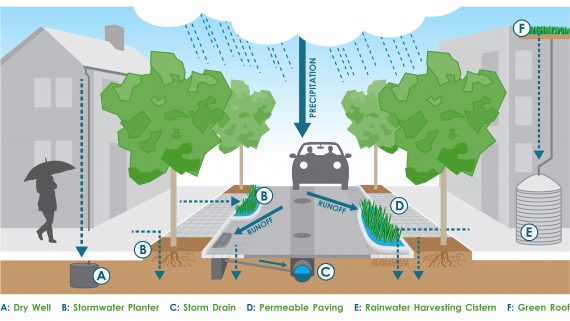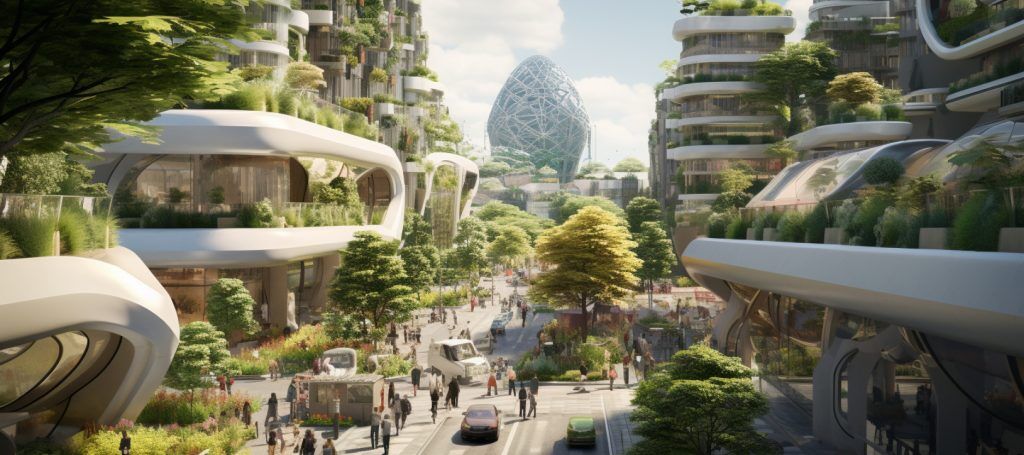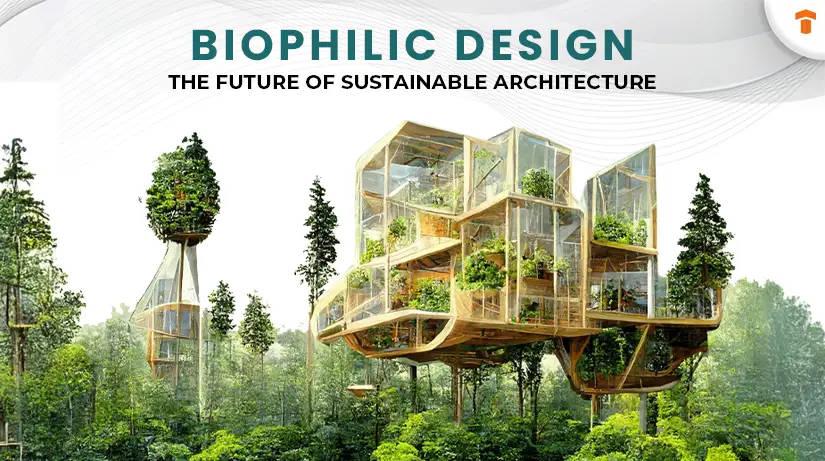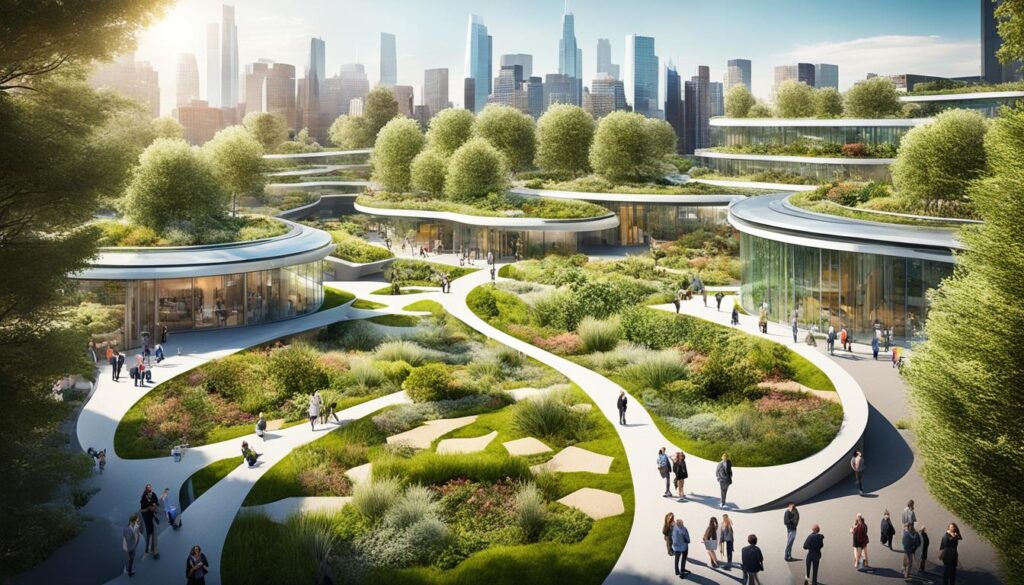Sustainable Urban Drainage Systems and Green Infrastructure.
As urbanization progresses, the effective management of stormwater and the enhancement of green spaces have become essential components for developing resilient cities.
Sustainable Urban Drainage Systems (SUDS) and green infrastructure are integral to addressing these pressing challenges.
This article aims to elucidate the concepts of SUDS and green infrastructure, their collaborative function, and the benefits they provide for water management and urban environments.
We will examine various types of SUDS, key elements of green infrastructure, and practical strategies that communities can adopt to implement these solutions effectively.
Through this exploration, the article will demonstrate how these approaches can significantly transform urban landscapes while addressing critical environmental issues.
What Are Sustainable Urban Drainage Systems (SUDS)?
.jpg_00.jpeg)
Sustainable Urban Drainage Systems (SUDS) represent advanced methodologies for managing surface runoff and stormwater in urban areas, aimed at reducing flooding and enhancing water quality.
These systems integrate a variety of techniques, including rain gardens, bio-retention systems, and permeable surfaces, which contribute to improving soil health and facilitating ecological restoration.
By prioritizing sustainable design and landscape architecture, SUDS are instrumental in urban planning, effectively addressing the challenges posed by climate change while promoting environmental sustainability and community resilience.
What Is Green Infrastructure?
Green Infrastructure pertains to meticulously planned networks of natural and semi-natural areas that deliver a variety of ecosystem services and bolster urban ecosystems.
By incorporating elements such as green roofs, rainwater harvesting systems, and urban forestry into city planning, green infrastructure enhances biodiversity and improves air quality while also contributing to climate resilience and fostering community engagement.
This strategy promotes the development of sustainable communities by establishing green spaces that facilitate habitat creation and resource efficiency.
How Do SUDS and Green Infrastructure Work Together?
Sustainable Urban Drainage Systems (SUDS) and Green Infrastructure function synergistically to establish a comprehensive approach to stormwater management and urban resilience.
By incorporating techniques such as stormwater harvesting and water-sensitive design, these systems not only enhance flood control but also improve water quality and support climate adaptation.
The collaboration between SUDS and green infrastructure facilitates more effective integrated water management, delivering multiple advantages for urban ecosystems and communities.
What Are the Benefits of SUDS and Green Infrastructure?
The advantages of Sustainable Urban Drainage Systems (SUDS) and Green Infrastructure are extensive, yielding positive impacts on both the environment and urban communities. These systems are essential for flood mitigation, enhancing water quality, and promoting urban biodiversity through the creation of habitats. Furthermore, they contribute to carbon sequestration and support public health by offering green spaces that facilitate outdoor activities and recreational opportunities.
By integrating vegetation and natural landscapes into urban planning, SUDS and green infrastructure establish healthier ecosystems that support local wildlife and promote pollinator populations. This approach not only enhances the aesthetic appeal of urban areas but also cultivates a sense of community and well-being among residents.
From an economic perspective, these green strategies can significantly reduce infrastructure costs related to water management while simultaneously increasing property values by improving the overall livability of neighborhoods. The synergy of these systems ultimately fosters sustainable development, creating resilient urban areas that seamlessly connect with nature while effectively addressing critical urban challenges.
What Are the Different Types of SUDS?
There are various types of Sustainable Urban Drainage Systems (SUDS), each specifically designed to manage stormwater efficiently while enhancing the overall health of urban environments.
Common types include:
- Permeable surfaces that facilitate the natural infiltration of water,
- Rain gardens that filter and retain runoff,
- Bio-retention systems that promote natural filtration,
- Green roofs that offer insulation and improve energy efficiency.
Additionally, constructed wetlands play a vital role in stormwater management by emulating natural processes to filter pollutants and recharge groundwater.
1. Permeable Pavement
Permeable pavement is a specialized surfacing material designed to facilitate water infiltration through its surface, thereby reducing surface runoff and promoting water retention in urban environments. This characteristic renders it a vital component of Sustainable Urban Drainage Systems (SUDS), as it effectively manages stormwater while minimizing the risks of flooding and erosion.
In urban areas dominated by concrete and asphalt, the capacity of permeable pavement to absorb rainwater offers a dual advantage: it not only alleviates pressure on conventional drainage systems but also enhances local groundwater recharge. Additionally, its porous structure aids in filtering pollutants, resulting in improved water quality as stormwater percolates through the material prior to reaching the subsurface.
The aesthetic versatility of permeable pavement allows it to integrate seamlessly into various landscapes, including parking lots and park pathways, making it an appealing option for architects and city planners who are seeking sustainable solutions.
By prioritizing effective stormwater management and water retention, urban communities can cultivate greener and more resilient environments.
2. Infiltration Basins
Infiltration basins are engineered to capture and temporarily store stormwater runoff, facilitating its percolation through the soil to recharge groundwater supplies. As a critical component of Sustainable Urban Drainage Systems (SUDS), these basins are instrumental in effective stormwater management and pollution control by filtering contaminants prior to their entry into larger water bodies.
The design of infiltration basins necessitates meticulous consideration of various factors, including soil type, basin size, and vegetation, all of which significantly affect the rate of infiltration and the efficiency of pollutant removal.
Optimal locations for these basins are typically areas characterized by high permeability of the underlying soil, which promotes rapid drainage and mitigates surface flooding. By enhancing natural hydrologic processes, infiltration basins contribute to the preservation of local ecosystems while also alleviating the urban heat island effect.
These multifunctional systems not only reduce flood risks but also foster biodiversity, resulting in healthier urban environments.
3. Rain Gardens
.jpg_01.jpeg)
Rain gardens are shallow, landscaped depressions specifically designed to capture and filter stormwater, thereby promoting natural filtration and enhancing water quality. As integral components of Sustainable Urban Drainage Systems (SUDS), they employ native vegetation to absorb and slow down runoff, yielding ecological benefits while enriching urban landscaping and biodiversity.
These gardens are essential tools in addressing the negative impacts of urbanization, which often results in increased stormwater runoff and pollution due to impermeable surfaces. By incorporating native plant species, rain gardens create habitats that support local wildlife, thereby fostering biodiversity in predominantly concrete environments.
Moreover, they assist in mitigating flooding by facilitating the percolation of water into the ground, which alleviates pressure on drainage systems. The aesthetic qualities of rain gardens further enhance the urban landscape, making neighborhoods more appealing and sustainable.
Rain gardens exemplify the effective integration of natural elements into urban planning, highlighting their importance in enhancing both ecological health and community resilience.
4. Green Roofs
Green roofs are vegetated surfaces installed on rooftops that offer numerous environmental benefits while contributing to Sustainable Urban Drainage Systems (SUDS). They play a significant role in mitigating the urban heat island effect, enhancing energy efficiency through improved insulation, and supporting biodiversity by providing habitats for various species.
Beyond these advantages, the integration of green roofs into urban infrastructure is essential for reducing stormwater runoff, thereby alleviating the pressure on drainage systems. The vegetation present on these roofs absorbs rainwater, leading to improved water quality by filtering pollutants before they enter the stormwater system.
As urban areas continue to expand, green roofs emerge as vital green spaces that promote mental well-being and encourage outdoor activities. By facilitating the creation of microclimates, these roofs also contribute to lowering urban temperatures, fostering a healthier environment for city residents.
The incorporation of green roofs not only addresses pressing environmental challenges but also enhances urban aesthetics and overall quality of life.
5. Constructed Wetlands
Constructed wetlands are engineered systems specifically designed to treat stormwater through natural processes that involve wetland vegetation, soil, and microorganisms. As a crucial component of Sustainable Urban Drainage Systems (SUDS) and green infrastructure, these systems offer efficient stormwater treatment while simultaneously promoting ecological restoration, habitat creation for wildlife, and water quality improvement.
These engineered systems emulate the functions of natural wetlands, providing effective filtration, nutrient removal, and enhancing biodiversity within urban landscapes. By incorporating constructed wetlands and other elements of green infrastructure into urban planning, communities can manage stormwater runoff more effectively, thereby minimizing flooding, improving water quality, and contributing to sustainable design.
Furthermore, these designs serve as essential green spaces, providing recreational opportunities and educational resources for residents. Their ecological significance is considerable, as they offer vital habitats for various species, thereby fostering urban ecosystems that support wildlife and promoting urban biodiversity.
Through careful design and strategic placement, constructed wetlands contribute to a healthier urban environment, successfully balancing development with nature while enhancing urban resilience and climate adaptation.
What Are the Key Elements of Green Infrastructure?
The key elements of Green Infrastructure consist of a range of natural and engineered systems that collaboratively enhance environmental quality, urban resilience, and climate resilience.
These elements include:
- Trees and vegetation, which offer shade, improve air quality, and enhance urban heat island effect mitigation;
- Green spaces that foster biodiversity and recreational opportunities;
- Ecological engineering practices that promote sustainable development, resource efficiency, and flood mitigation within urban landscapes.
1. Trees and Vegetation
Trees and vegetation represent a critical component of green infrastructure, providing vital ecosystem services such as carbon sequestration, enhancement of air quality, and habitat for urban wildlife. Their integration into urban landscapes not only elevates aesthetic appeal but also contributes to biodiversity, stormwater management, and the overall well-being of the community.
The strategic planting of trees can effectively mitigate the urban heat island effect, promoting cooler temperatures in densely populated areas and subsequently reducing energy demand. These green spaces facilitate improved mental health by offering residents a natural refuge from the pressures of urban life. The diversity of plant life supports a wide range of species that thrive within an urban environment, thereby fostering biodiversity and improving ecosystem services.
Furthermore, involving communities in the planting and maintenance of green spaces strengthens social cohesion, as individuals unite around a shared objective. This collaborative effort promotes a sense of ownership and stewardship toward their environment, enhancing the overall quality of life within the community and promoting community engagement.
2. Green Spaces and Parks
Green spaces and parks are essential elements of urban planning and green infrastructure, providing vital areas for recreation, relaxation, and social interaction within communities. These spaces not only enhance public health by promoting physical activity but also encourage community engagement, foster environmental awareness, and support public health.
Moreover, green spaces serve as critical habitats for biodiversity, supporting a variety of species and contributing to urban ecology. A well-designed park can function as a “green lung” for a city, improving air quality, providing natural water management, and mitigating the urban heat island effect, thereby facilitating more sustainable urban living.
Research indicates that easy access to nature is associated with lower stress levels and improved mental health outcomes among residents. These spaces promote interactions among diverse community members, thereby enhancing social cohesion, fostering a sense of belonging, and contributing to community resilience.
As urban planners increasingly acknowledge the multifaceted value of green spaces, their integration into city landscapes will be imperative for the development of resilient, healthy, and vibrant urban environments.
3. Urban Farms and Gardens
Urban farms and gardens play a significant role in enhancing green infrastructure by promoting local food security, increasing biodiversity, and fostering community development. These spaces are essential resources for urban populations, providing access to fresh produce while also supporting educational initiatives centered on sustainable practices, environmental stewardship, and urban agriculture.
Plus offering nutritious food options, urban green spaces are crucial for enhancing urban biodiversity by attracting pollinators, birds, and beneficial insects. They also create opportunities for community engagement, facilitating connections among residents through volunteer programs, workshops, community gardens, and farmers’ markets.
As neighbors collaborate to cultivate these gardens, they instill a sense of ownership and pride in their community, which can lead to improved social cohesion, collaboration, and urban regeneration.
Furthermore, urban farms frequently serve as demonstration sites for innovative agricultural techniques, thereby promoting ecological awareness, urban greening, and inspiring other communities to adopt similar sustainable practices.
4. Green Streets and Alleys
.jpg_10.jpeg)
Green streets and alleys represent innovative components of urban greening initiatives aimed at improving stormwater management and fostering sustainability within urban environments. By incorporating vegetation, permeable surfaces, and eco-friendly materials, these areas enhance community resilience while elevating the aesthetic appeal and functionality of urban landscapes, contributing to infrastructure resilience.
These initiatives play a vital role in absorbing rainfall, thereby reducing runoff and alleviating the burden on sewage systems, which in turn mitigates the risk of flooding during significant storm events. Green streets and alleys utilize permeable paving and bio-retention areas to manage stormwater. They have the potential to revitalize neglected urban spaces, transforming them into vibrant community hubs that promote social interaction and instill a sense of pride among residents.
The integration of native plants not only bolsters biodiversity but also provides essential habitats for local wildlife, thereby enriching the urban ecosystem. Communities that actively participate in the creation and maintenance of these green spaces frequently experience heightened environmental awareness, cohesion, and participation in ecological urbanism, resulting in a stronger, more united neighborhood committed to sustainable living.
How Can SUDS and Green Infrastructure Help with Water Management?
Sustainable Urban Drainage Systems (SUDS) and Green Infrastructure are essential components in the enhancement of water management strategies and natural drainage within urban environments.
These systems effectively manage floodwaters and promote groundwater recharge, thereby improving water quality, reducing runoff, and mitigating the adverse effects of stormwater runoff on local ecosystems.
1. Reducing Flooding and Erosion
Reducing flooding and erosion constitutes one of the primary benefits of implementing Sustainable Urban Drainage Systems (SUDS) and Green Infrastructure in urban planning. These systems effectively manage stormwater runoff, enabling controlled infiltration and stormwater harvesting, which mitigates the intensity of flooding events and reduces soil erosion along watercourses.
SUDS employs various techniques, including permeable pavements, green roofs, and bioretention areas, which facilitate the absorption of rainwater and consequently decrease surface runoff. By permitting water to infiltrate the ground, these methods contribute to groundwater recharge and alleviate peak flow rates during heavy rainfall, thereby lowering the risk of urban flooding. These techniques exemplify low impact development in urban planning.
In addition, green infrastructure, such as urban parks, rain gardens, and vegetated swales, enhances the urban landscape while functioning as a natural sponge that absorbs excess water and promotes ecological restoration. The effectiveness of these techniques highlights their significance in stormwater management, enhancing the resilience of cities to the impacts of climate change while simultaneously reducing erosion, improving environmental quality, and contributing to natural flood management.
2. Improving Water Quality
Improving water quality is a significant advantage of Sustainable Urban Drainage Systems (SUDS) and Green Infrastructure, which employ natural filtration techniques to remove pollutants from stormwater. These systems effectively mitigate the impacts of urban runoff, ensuring that water entering local water bodies is cleaner and healthier for both ecosystems and communities. Natural filters such as bioswales and infiltration systems play a crucial role in this process.
By incorporating various elements such as rain gardens, permeable pavements, and vegetated swales, these approaches proficiently capture and treat runoff before it reaches drains and rivers. Techniques such as sedimentation, bioswales, and biological uptake play essential roles in the removal of pollutants, facilitating the breakdown of harmful substances through natural processes.
Furthermore, the integration of green roofs can absorb and filter rainwater, significantly reducing the volume of runoff. SUDS and green infrastructure not only enhance water quality but also promote biodiversity, urban greening, and improve the aesthetic value of urban areas.
3. Replenishing Groundwater Supplies
Replenishing groundwater supplies is a critical function of Sustainable Urban Drainage Systems (SUDS) and Green Infrastructure, which facilitate the natural replenishment of aquifers through the infiltration of stormwater. By promoting water retention and reducing surface runoff, these systems contribute to effective sustainable water management practices in urban areas. This process also supports the enhancement of soil health and hydrology.
The innovative designs of SUDS and Green Infrastructure, including rain gardens, permeable pavements, and green roofs, emulate natural hydrological processes, allowing water to percolate through the soil layers. This stormwater management process not only aids in the filtration of pollutants but also enhances the recharging of groundwater tables, thereby promoting healthier ecosystems and supporting urban greening efforts.
By implementing these sustainable practices, cities can effectively mitigate the negative impacts of urbanization, such as flooding and water scarcity, ensuring a more resilient and ecologically balanced environment for future generations through better flood mitigation and water quality improvement.
What Are the Challenges and Limitations of SUDS and Green Infrastructure?
Despite the numerous advantages associated with Sustainable Urban Drainage Systems (SUDS) and Green Infrastructure, several challenges and limitations, including climate resilience considerations, can hinder their effective implementation.
Key considerations include high initial costs, ongoing maintenance requirements, and the constraints of limited space in densely populated urban areas. These factors must be carefully evaluated when integrating these systems into urban planning initiatives.
1. High Initial Costs
The substantial initial costs associated with the installation of Sustainable Urban Drainage Systems (SUDS) and Green Infrastructure present a significant barrier to their widespread adoption. Financial considerations, particularly budget constraints at the municipal level, often limit the capacity to implement these environmentally beneficial practices, affecting infrastructure resilience.
Municipalities can explore various funding sources, including green infrastructure financing, to address these challenges. Grants from governmental and non-profit organizations that support ecological initiatives can serve as a viable option. Additionally, public-private partnerships can provide the necessary financial backing while sharing the associated risks.
Communities may also consider adopting innovative financing strategies, such as green bonds or impact investing, which target investors seeking to achieve environmental benefits in conjunction with financial returns. Furthermore, investing in the training of local engineers and planners can support long-term sustainability efforts, ensuring the effective implementation and maintenance of SUDS and stormwater harvesting systems.
By leveraging these strategies, cities can overcome the challenges posed by high upfront investments and promote more resilient urban environments, enhancing community resilience and urban sustainability.
2. Maintenance and Management
.jpg_11.jpeg)
The effective maintenance and management of Sustainable Urban Drainage Systems (SUDS) and Green Infrastructure are essential for ensuring their long-term functionality and sustainability. Regular care, including systematic inspections and vegetation management, is necessary to uphold the effectiveness of these systems in urban environments and maintain urban biodiversity.
Plus these practices, it is imperative to address potential challenges such as pollution control, sediment accumulation, and biodiversity enhancement. A proactive approach not only aids in preserving the ecological benefits provided by these systems but also ensures compliance with environmental regulations.
The integration of community involvement in maintenance programs can significantly enhance sustainability efforts, as local stakeholders often possess valuable insights into the specific needs and conditions of their areas. Furthermore, overcoming budget constraints and prioritizing education regarding the importance of SUDS with a focus on environmental sustainability can enable cities to adapt and flourish as they pursue greener futures.
3. Limited Space and Land Availability
Limited space and land availability in densely populated urban areas present significant challenges for the implementation of Sustainable Urban Drainage Systems (SUDS) and Green Infrastructure. Urban density frequently restricts opportunities for establishing green spaces and infrastructure that are essential for effective stormwater management and the enhancement of environmental quality through natural water management and low impact development.
Consequently, innovative planning policies are critical for maximizing the integration of these systems within the existing urban fabric. Approaches such as green roofs, permeable pavements, and vertical gardens offer effective solutions that optimize limited land while also enhancing aesthetic value and addressing the urban heat island effect.
Cities are increasingly adopting zoning regulations that incentivize developers to incorporate sustainable practices into their projects, thereby ensuring that urban landscapes become more resilient to flooding and climate change. By fostering collaboration among stakeholders, these strategies can promote an ecosystem of sustainable practices that address the constraints posed by urban density and enhance stormwater runoff management.
How Can Communities Implement SUDS and Green Infrastructure?
Communities can effectively implement Sustainable Urban Drainage Systems (SUDS) and Green Infrastructure through collaborative efforts that emphasize environmental education, community engagement, and participatory planning.
By actively involving local stakeholders in the planning process, communities can create and maintain systems that not only enhance urban resilience and ecological urbanism but also promote sustainable practices.
Frequently Asked Questions
What are Sustainable Urban Drainage Systems (SUDS)?
Sustainable Urban Drainage Systems (SUDS) are innovative approaches to managing rainwater in urban areas that mimic natural processes, enhancing ecological drainage and decreasing the impact of urbanization on the water cycle and local ecosystems.
What is Green Infrastructure?
Green Infrastructure refers to the network of natural and semi-natural features, such as green roofs, rain gardens, and permeable pavement, that are used to manage and treat stormwater in urban areas, contributing to ecosystem services and urban development.
How do Sustainable Urban Drainage Systems and Green Infrastructure benefit urban areas?
Sustainable Urban Drainage Systems and Green Infrastructure provide numerous benefits to urban areas, including reducing flooding, improving water quality, enhancing biodiversity, and creating more livable and attractive communities through urban landscaping and habitat restoration.
What are some examples of Sustainable Urban Drainage Systems and Green Infrastructure?
Examples of Sustainable Urban Drainage Systems and Green Infrastructure include bioretention basins, green roofs, permeable pavement, rain gardens, constructed wetlands, and bioswales.
Are there any potential challenges or limitations to implementing Sustainable Urban Drainage Systems and Green Infrastructure?
Some potential challenges or limitations include the need for proper design and maintenance, high initial costs, potential conflicts with existing infrastructure or land use plans, and the necessity of ecological footprint reduction.
How can communities encourage the use of Sustainable Urban Drainage Systems and Green Infrastructure?
Communities can encourage the use of Sustainable Urban Drainage Systems and Green Infrastructure by providing incentives such as financial assistance or streamlined permitting processes, conducting outreach and education, and incorporating these systems into planning and development policies, thus advancing environmental justice and climate adaptation.

I’m Bruno, an architect with a deep passion for Biophilic Design in Urban Architecture. Throughout my career, I’ve focused on integrating natural elements into urban planning, and I created this site to share my insights and foster a deeper understanding of how biophilic principles can significantly enhance urban living. Dedicated to sustainable development, I continually explore innovative design solutions that promote both environmental and human well-being in city landscapes.














Publicar comentário